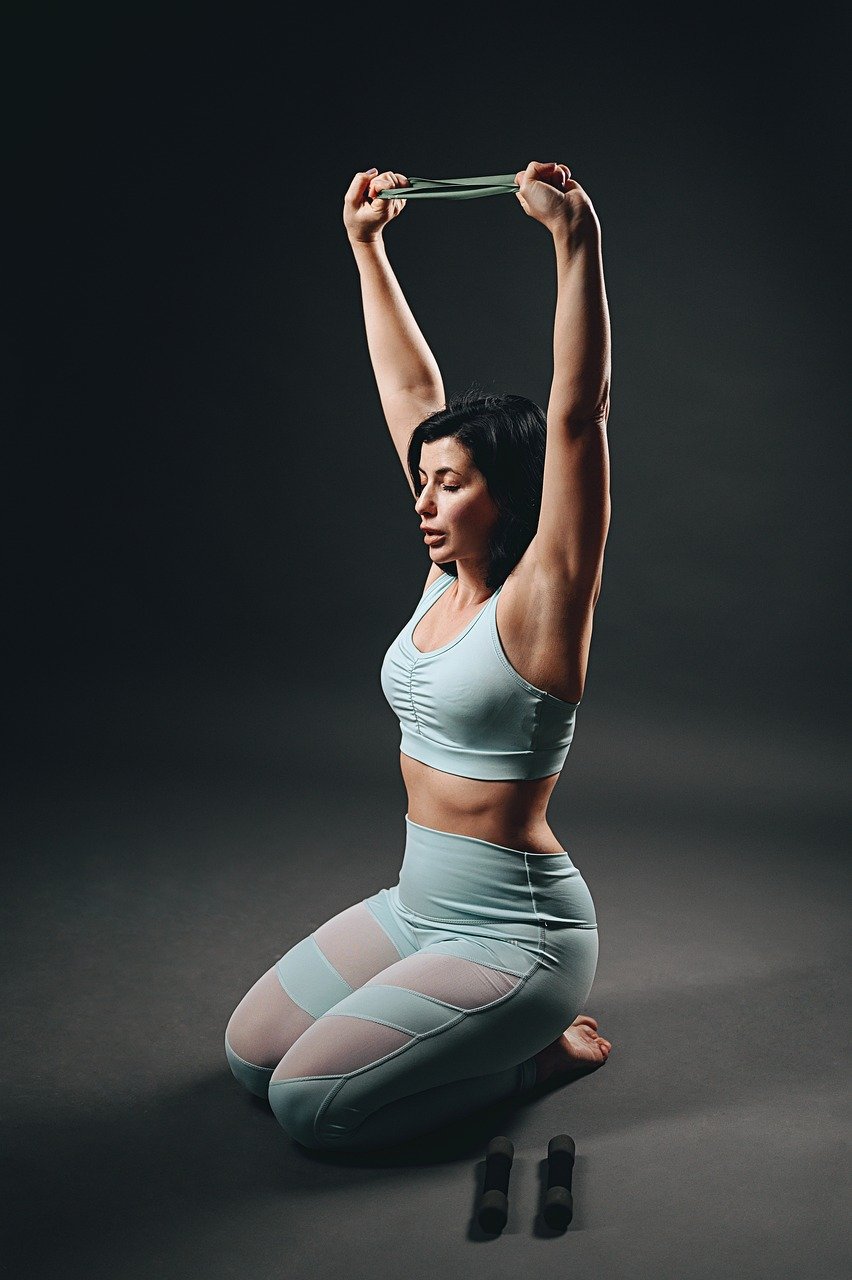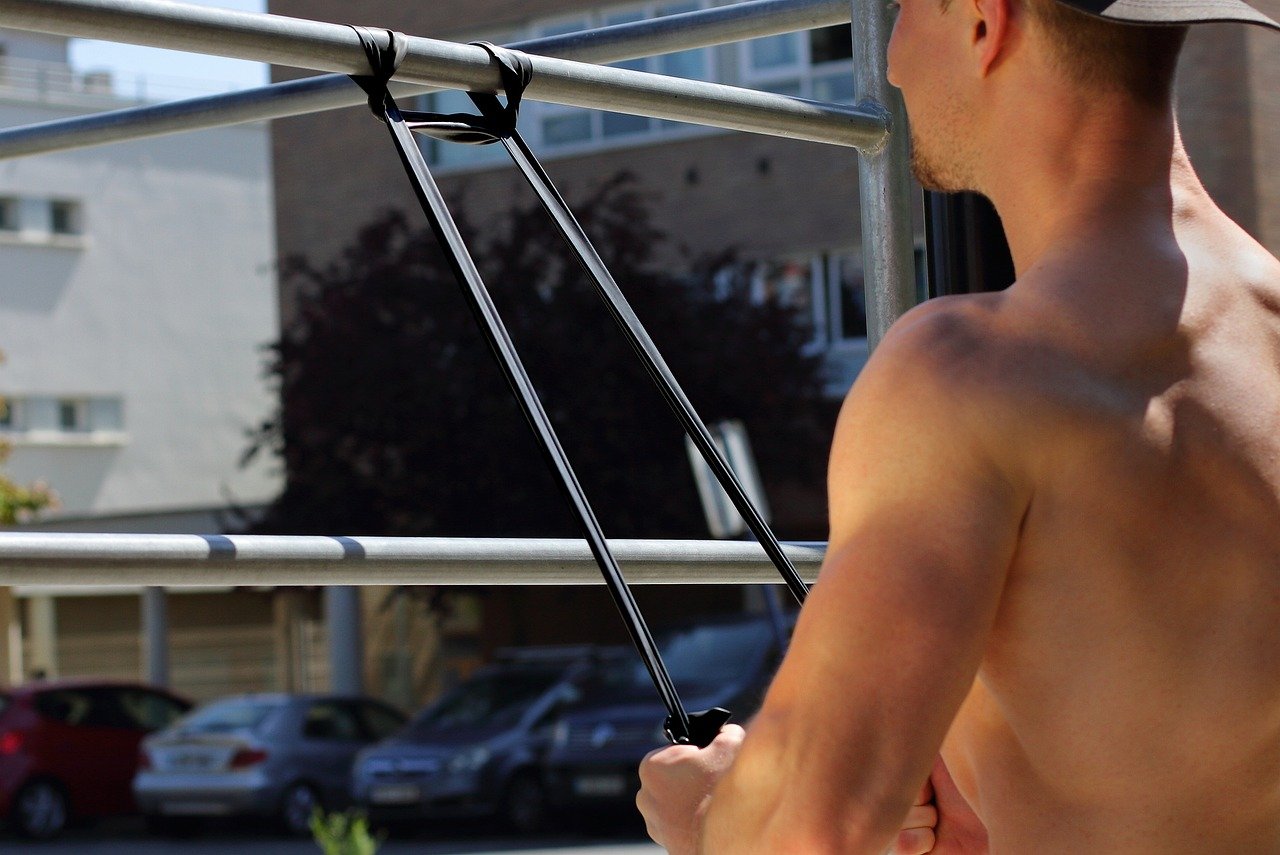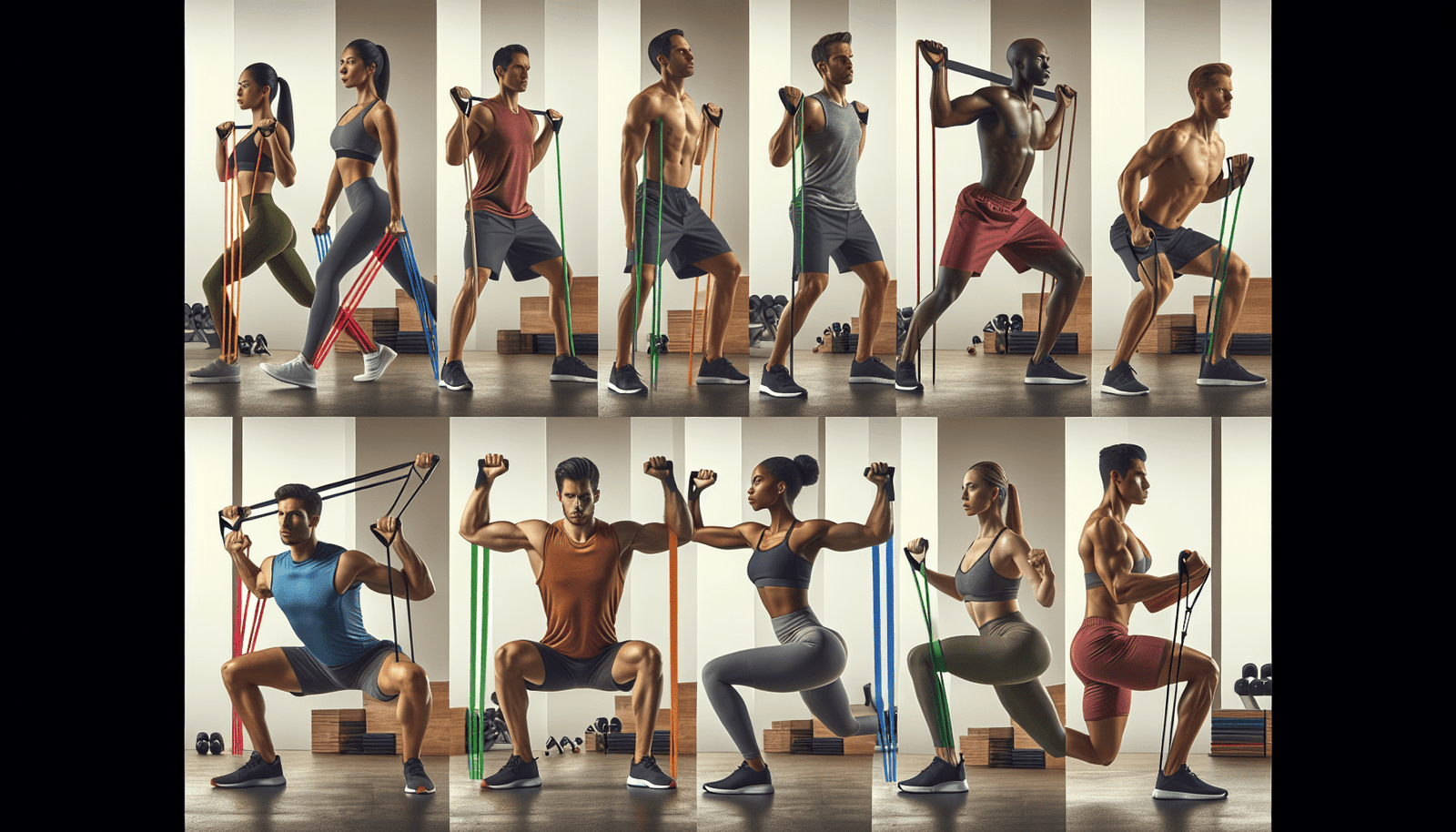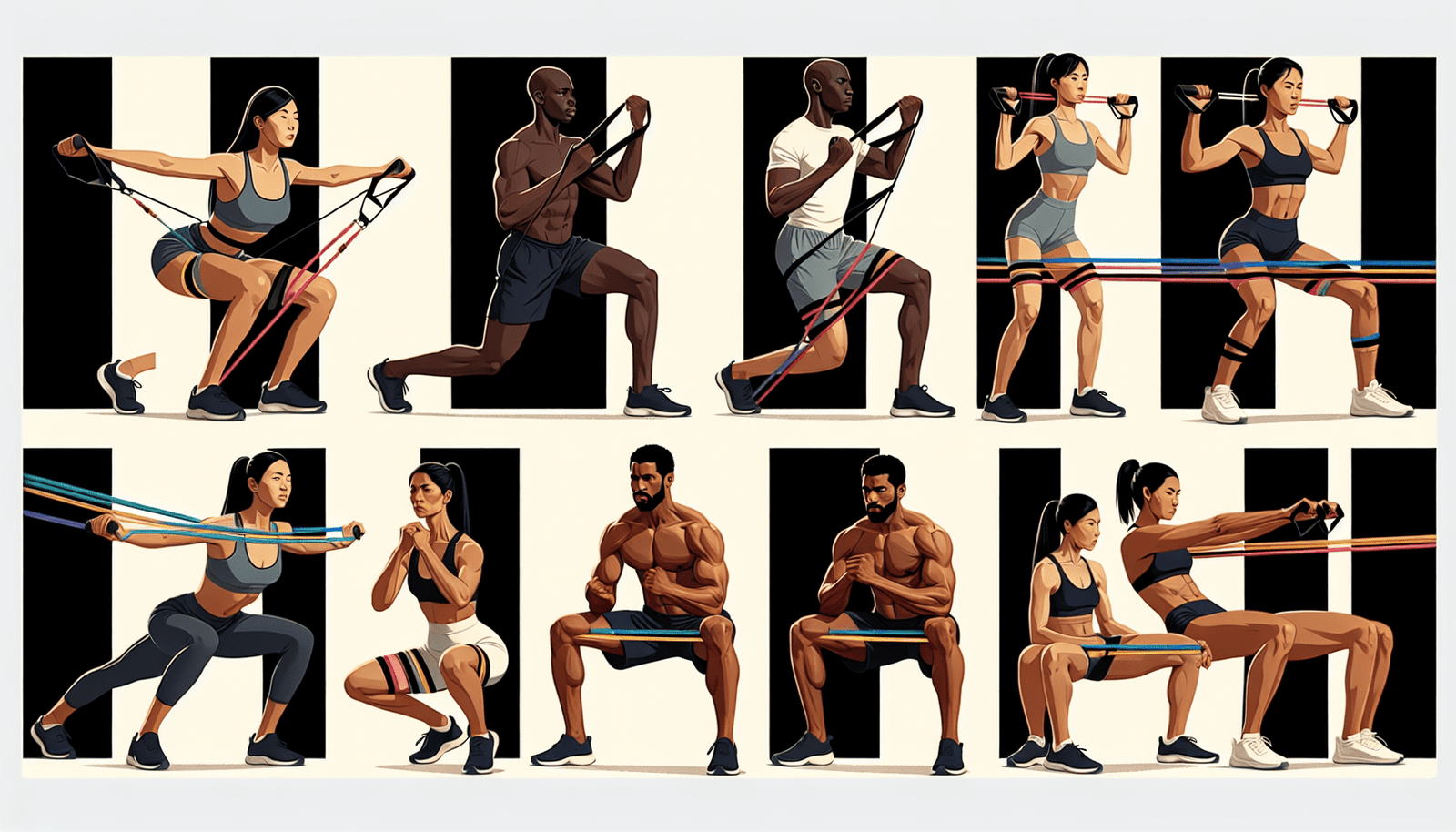Are you looking for a versatile and convenient way to achieve a full body workout? Look no further than resistance bands! In this article, we will explore seven effective resistance band exercises that will target various muscle groups, providing you with a comprehensive workout routine. Whether you are a beginner or an experienced fitness enthusiast, these exercises can be easily incorporated into your fitness regimen, ensuring that you achieve your fitness goals in a fun and efficient manner. Get ready to challenge your muscles and improve your strength and flexibility with these simple yet impactful resistance band exercises!
What are resistance bands?
Resistance bands are versatile and portable exercise equipment that can be used to add resistance to your workouts. They are typically made of latex or rubber and come in various colors and sizes. Resistance bands offer a convenient and affordable way to strengthen and tone your muscles, without the need for bulky weights or expensive gym equipment. Whether you’re a beginner or an advanced fitness enthusiast, resistance bands can be a valuable addition to your exercise routine.
Description of resistance bands
Resistance bands are elastic bands that provide varying levels of resistance when stretched. They are commonly used for strength training, rehabilitation exercises, and flexibility training. These bands are available in different thicknesses and lengths, each offering a different level of resistance. The thicker the band, the more resistance it provides. Some resistance bands are looped, while others are flat and can be tied into a loop or used as a straight band.

Benefits of using resistance bands
Using resistance bands in your workouts offers several benefits:
-
Versatility: Resistance bands can be used for a wide range of exercises targeting different muscle groups. From upper body workouts to lower body exercises and core strengthening, resistance bands offer a versatile way to train your entire body.
-
Portability: One of the biggest advantages of resistance bands is their portability. They are lightweight and easily fit into a bag or suitcase, making them ideal for travel or home workouts. You can continue your fitness routine wherever you go.
-
Joint-Friendly: Resistance bands provide a smoother and more controlled resistance compared to weights or machines. This makes them a great option for individuals with joint issues or those undergoing rehabilitation. The bands allow for a full range of motion while minimizing the risk of injury.
-
Variable Resistance: Resistance bands offer the advantage of variable resistance. As you stretch the band, the resistance increases, challenging your muscles throughout the entire range of motion. This can help improve muscle strength, endurance, and flexibility.
-
Affordable: Compared to other exercise equipment, resistance bands are relatively inexpensive. You can purchase a set of resistance bands at an affordable price, making them a cost-effective option for anyone looking to incorporate strength training into their fitness routine.
Choosing the right resistance band
When selecting a resistance band, it’s important to consider your fitness level and the exercises you plan to perform. Here are two key factors to consider:
1. Understanding different resistance levels
Resistance bands come in different levels of resistance, typically categorized by colors or strength ratings. The resistance level determines how much tension the band offers when stretched. Common color-coded resistance levels include light (yellow), medium (green), and heavy (red or black). It’s essential to choose a band that provides enough resistance to challenge your muscles without compromising proper form.
2. Considerations for different exercises
Different exercises require different levels of resistance. While some exercises may require more resistance, others may need lighter bands. For example, exercises that target larger muscle groups like squats or chest presses may require a heavier resistance band. On the other hand, exercises that focus on smaller muscle groups like bicep curls or shoulder raises may require a lighter band. Consider the specific exercises you plan to perform and choose resistance bands accordingly to ensure optimal results.

Safety precautions
While resistance bands are generally safe to use, it’s important to follow these safety precautions to minimize the risk of injury:
1. Checking the integrity of the band
Before each workout, inspect your resistance bands for any signs of wear and tear, such as cracks, fraying, or weak spots. If you notice any damage, replace the band to prevent the risk of the band breaking during exercise.
2. Proper warm-up and stretching exercises
Just like any other workout, it’s crucial to warm up your muscles before using resistance bands. Perform dynamic stretches or a light cardio warm-up to increase blood flow to the muscles and prepare your body for the workout. This can help prevent muscle strains or injuries.
3. Maintaining proper form and technique
To ensure safe and effective workouts, it’s essential to maintain proper form and technique when using resistance bands. Pay attention to your body alignment and control the tension of the band throughout each exercise. Avoid jerking or snapping the band, as this can lead to muscle strains or accidents. If you’re unsure about proper form, consider working with a certified fitness professional or watching instructional videos to learn the correct technique for each exercise.
Resistance band exercises for upper body
Resistance bands can effectively target your upper body muscles and help you build strength and definition. Here are five popular resistance band exercises for the upper body:
1. Bicep curls
To perform bicep curls with resistance bands, stand with your feet shoulder-width apart, place the band under your feet, and hold the handles with your palms facing forward. Keeping your elbows close to your sides, slowly curl the handles upward, contracting your biceps. Pause for a moment at the top, then slowly lower the handles back down to the starting position.
2. Tricep extensions
Start by standing on the resistance band with your feet hip-width apart. Hold the handles with your palms facing inward and extend your arms straight above your head. Slowly bend your elbows, lowering the handles behind your head while keeping your upper arms stationary. Pause for a moment, then straighten your arms to return to the starting position.
3. Overhead presses
Stand on the resistance band with your feet hip-width apart and hold the handles at shoulder height. Keep your palms facing forward. Press the handles straight up overhead, fully extending your arms. Pause at the top, then lower the handles back down to shoulder height.
4. Rows
Anchor the resistance band securely to a stationary object at waist height. Stand facing the anchor point, holding the handles with your palms facing each other. Start with your arms fully extended in front of you, then retract your shoulder blades and pull the handles back, bending your elbows. Squeeze your shoulder blades together at the end of the movement, then return to the starting position.
5. Chest presses
Secure the resistance band to a sturdy object at chest height. Stand facing away from the anchor point, holding the handles at chest level with your palms facing down. Step forward to create tension in the band, then push the handles straight forward until your arms are fully extended. Pause briefly, then slowly bring your hands back to chest level.

Resistance band exercises for lower body
Resistance bands can help strengthen and tone the muscles in your lower body without putting excessive stress on your joints. Here are five effective resistance band exercises for the lower body:
1. Squats
Place the resistance band around your thighs, just above your knees. Stand with your feet hip-width apart, toes slightly turned out. Keeping your chest lifted and back straight, slowly bend your knees and lower your body into a squat position. Push through your heels to return to the starting position, squeezing your glutes at the top.
2. Lunges
Step on the resistance band with one foot, and then step your other foot back into a lunge position. The band should be anchored under the arch of your back foot. Keeping your upper body tall, bend both knees and lower your back knee towards the ground. Push through your front heel to stand back up, engaging your glutes. Repeat on the opposite side.
3. Glute bridges
Lie flat on your back with your knees bent and feet hip-width apart. Place the resistance band just above your knees. Engage your glutes and lift your hips off the ground until your body forms a straight line from knees to shoulders. Squeeze your glutes at the top, then slowly lower your hips back to the starting position.
4. Leg extensions
Sit on the edge of a chair or bench and anchor the resistance band around one foot. Extend your leg straight, keeping your back tall and core engaged. Slowly flex your foot and lift your leg as high as possible, squeezing your quadriceps. Pause for a moment, then lower your leg back down. Repeat on the other leg.
5. Calf raises
Stand on the resistance band with both feet and hold the handles at shoulder height. Raise your heels off the ground and stand on your toes, squeezing your calves. Lower your heels back down to the ground and repeat the movement.
Resistance band exercises for core
In addition to targeting your upper and lower body, resistance bands can also be used to engage and strengthen your core muscles. Here are five effective resistance band exercises for your core:
1. Russian twists
Sit on the ground with your knees bent and heels on the floor. Hold the resistance band with both hands and extend your arms straight in front of you. Lean back slightly and engage your core. Twist your upper body to the right, bringing the band across your body. Return to the center and then twist to the left. Repeat the movement in a controlled manner.
2. Plank with band pull
Assume a plank position with the resistance band wrapped around your wrists. Your body should form a straight line from head to heels. Engage your core and pull one hand out to the side, stretching the band. Return to the center and repeat the movement with the other hand. Alternate sides in a controlled manner.
3. Standing oblique twists
Stand with your feet hip-width apart and hold the resistance band with both hands. Keep your arms extended in front of you, shoulder-width apart. Engage your core and twist your upper body to the right, pulling the band across your body. Return to the center and then twist to the left. Repeat the movement in a controlled manner.
4. Seated band rotations
Sit on the floor with your legs extended straight in front of you. Wrap the resistance band around your feet and hold the ends with both hands. Lean back slightly, keeping your back straight and core engaged. Rotate your upper body to the right, pulling the band across your body. Return to the center and then rotate to the left. Repeat the movement in a controlled manner.
5. Reverse crunches
Lie flat on your back with your knees bent and feet lifted off the ground, thighs perpendicular to the floor. Anchor the resistance band to a sturdy object behind you and hold the handles with your arms extended above your chest. Engage your core and lift your hips off the ground, pulling the band towards your chest. Lower your hips back down to the starting position and repeat the movement.

Combining resistance band exercises
To maximize the effectiveness of your resistance band workouts, you can combine different exercises to create a well-rounded full-body workout. Here are three ways to combine resistance band exercises:
1. Full body circuit workout
Create a circuit by choosing exercises that target different muscle groups. Perform each exercise for a set number of repetitions or time, then move on to the next exercise. Rest for a short period before repeating the circuit for multiple rounds. This can ensure that you engage your entire body and get a comprehensive workout.
2. Superset workouts
Pair two exercises back-to-back that target opposing muscle groups. For example, pair bicep curls with tricep extensions or squats with glute bridges. Perform one exercise immediately after the other, without resting in between. This allows you to save time and challenge multiple muscle groups in a single workout.
3. Interval training with resistance bands
Incorporate intervals of higher intensity into your resistance band workouts. Perform exercises at a higher intensity for a set period, such as 30 seconds, followed by a short recovery period. This can help increase your heart rate, burn more calories, and improve cardiovascular fitness. Add resistance bands to exercises like jumping jacks, mountain climbers, or high knees to further increase the challenge.
Tips for maximizing the effectiveness
To make the most out of your resistance band workouts, consider these tips:
1. Gradually increase resistance
As your muscles get stronger, gradually increase the resistance of your bands to continue challenging your body. This can be done by using thicker bands or doubling up on bands to increase tension.
2. Vary the exercises and angles
To avoid plateauing, incorporate a variety of resistance band exercises into your workouts. Change up the exercises, angles, and grips to target your muscles from different angles and challenge them in new ways. This can help prevent boredom and promote muscle growth.
3. Utilize proper breathing techniques
Focus on your breath during resistance band exercises. Inhale during the eccentric phase (when the muscle lengthens) and exhale during the concentric phase (when the muscle contracts). Proper breathing helps stabilize your core and provides energy for your muscles.
4. Maintain consistency and progression
Consistency is key for achieving long-term results. Make resistance band workouts a regular part of your exercise routine. Track your progress, gradually increasing the intensity or volume of your workouts. This incremental progression will help you build strength and endurance over time.
Sample resistance band workout routine
Here’s a sample resistance band workout routine that incorporates exercises for different muscle groups:
Warm-up exercises
-
Arm circles: Stand with your feet shoulder-width apart and extend your arms out to the sides. Make small circles with your arms, gradually increasing the size of the circles. Repeat for 30 seconds.
-
Leg swings: Stand next to a wall or support and extend one leg out to the side. Swing the leg forward and backward, keeping it straight. Repeat for 10 swings on each leg.
-
Torso rotations: Stand with your feet shoulder-width apart and place the resistance band around your upper back, holding the ends with your hands. Twist your torso from side to side, keeping your hips stable. Repeat for 30 seconds.
Upper body exercises
- Bicep curls: 3 sets of 12 repetitions
- Tricep extensions: 3 sets of 12 repetitions
- Overhead presses: 3 sets of 10 repetitions
- Rows: 3 sets of 10 repetitions
- Chest presses: 3 sets of 12 repetitions
Lower body exercises
- Squats: 3 sets of 15 repetitions
- Lunges: 3 sets of 12 repetitions on each leg
- Glute bridges: 3 sets of 12 repetitions
- Leg extensions: 3 sets of 12 repetitions on each leg
- Calf raises: 3 sets of 15 repetitions
Core exercises
- Russian twists: 3 sets of 20 repetitions (10 twists on each side)
- Plank with band pull: 3 sets of 12 repetitions (6 pulls on each side)
- Standing oblique twists: 3 sets of 15 repetitions on each side
- Seated band rotations: 3 sets of 12 repetitions on each side
- Reverse crunches: 3 sets of 15 repetitions
Cool-down and stretching
After completing the workout, cool down by performing light cardio exercises such as brisk walking or jogging for 5-10 minutes. Follow it with static stretches for the major muscle groups, holding each stretch for 20-30 seconds.
Conclusion
Incorporating resistance bands into your regular exercise routine can provide numerous benefits. From improved muscle strength and endurance to increased flexibility and portability, resistance bands are a versatile and effective tool for full-body workouts. Start by choosing the right resistance band for your fitness level and gradually progress to more challenging exercises. Remember to prioritize safety by checking the integrity of the bands, warming up properly, and maintaining proper form. With consistency and progression, you will be well on your way to reaping the benefits of resistance band workouts. So grab your resistance bands and get ready to take your fitness to the next level!